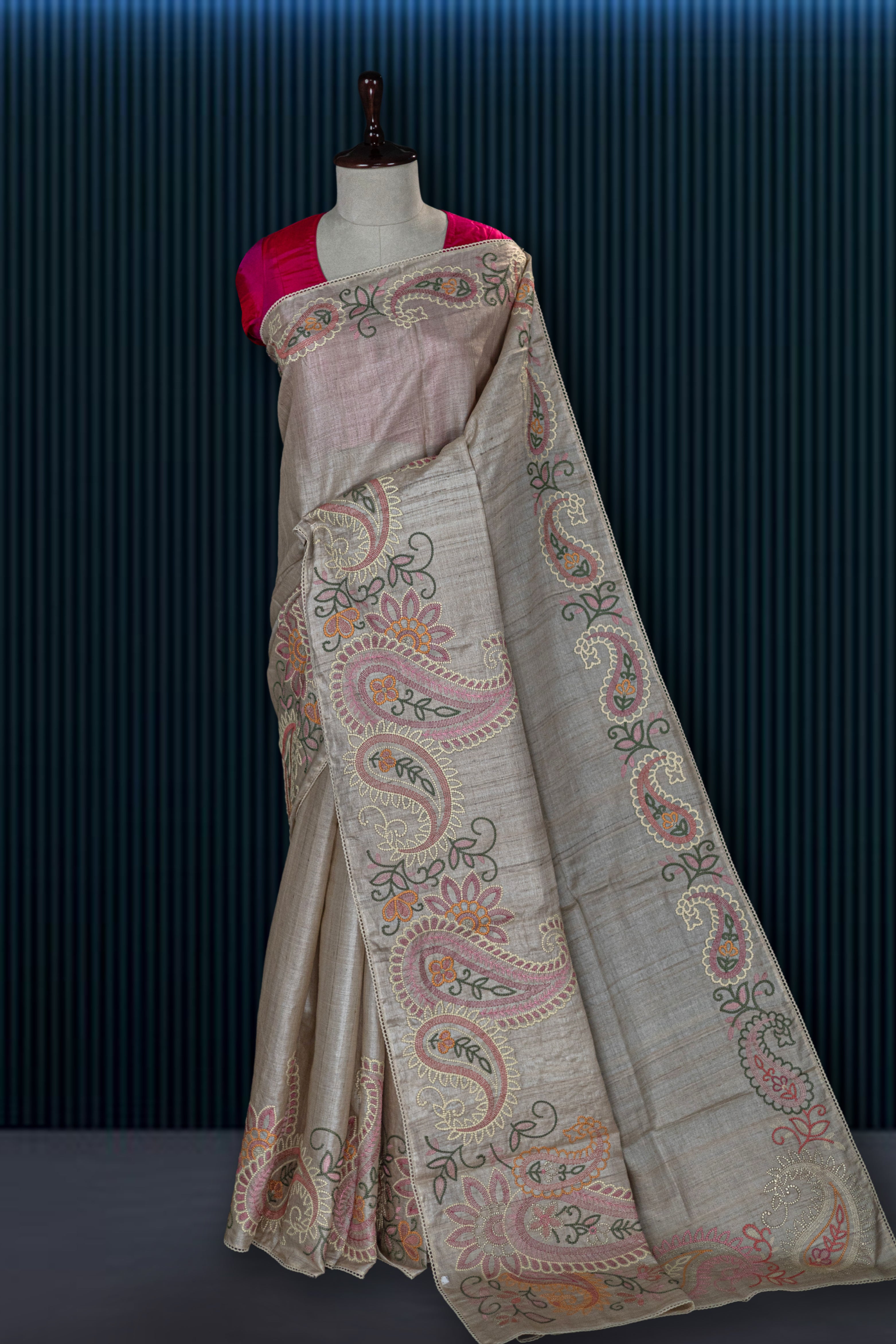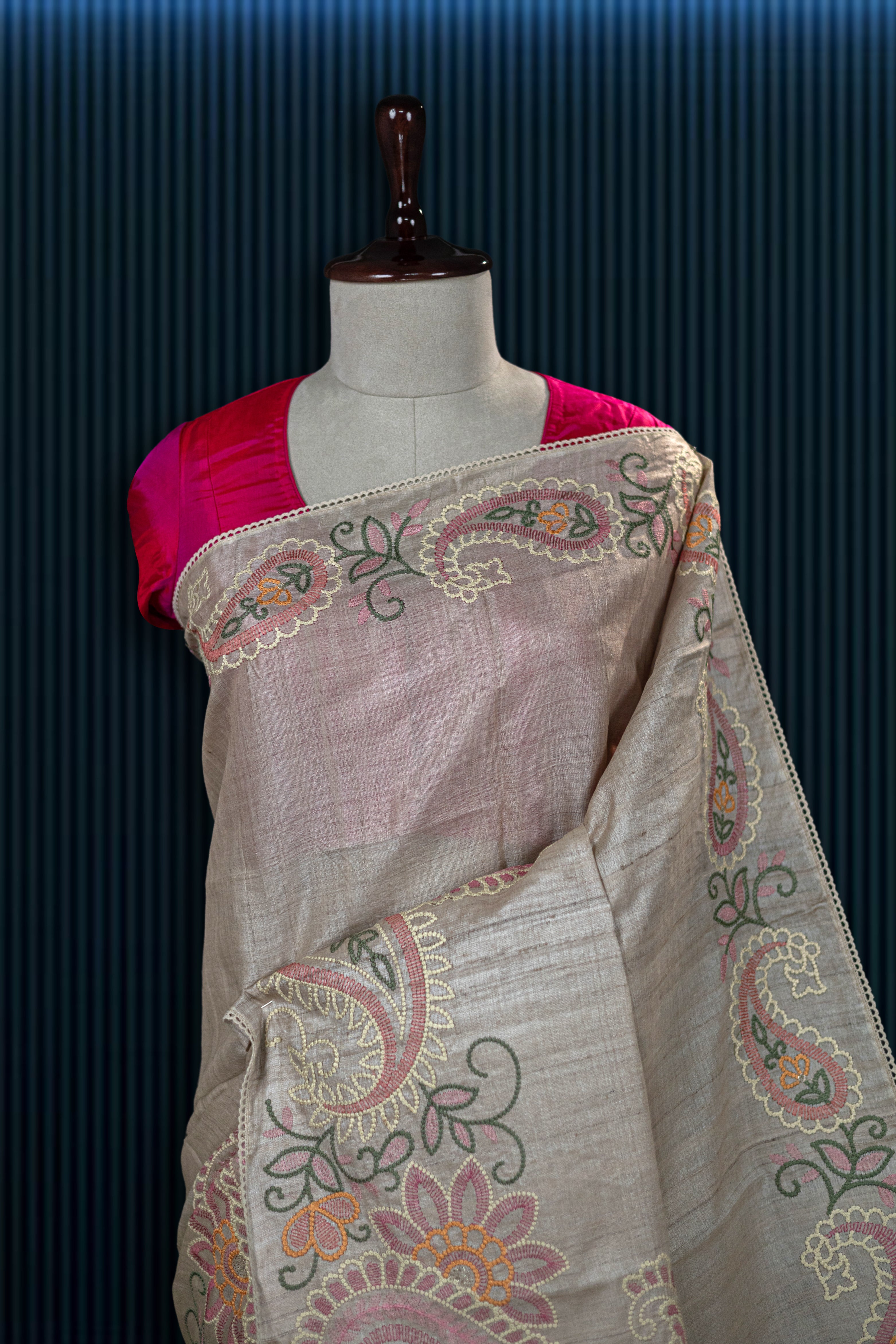A Tussar Machine Work Saree is a modern variation of the traditional Tussar silk saree, where machine embroidery or machine work is used to embellish the fabric, adding intricate designs, patterns, and textures. Here’s an explanation of the key elements that make up this style:
1. Tussar Silk:
Tussar silk is a type of wild silk that is produced by wild silkworms, mainly found in India. It is known for its rich texture, natural golden or beige tone, and slightly coarse feel compared to traditional mulberry silk. Tussar silk is prized for its organic, rustic appeal and is often used for creating elegant, traditional sarees.
-
Natural Appearance: Tussar silk has a unique, natural sheen and is less glossy than mulberry silk, which gives it a more understated elegance.
-
Comfortable and Breathable: Tussar silk is often favored for its breathability, making it suitable for warmer climates or long events.
2. Machine Work (Machine Embroidery):
Machine embroidery is the process of using machines (such as computerized embroidery machines) to stitch intricate designs onto fabric. This method allows for detailed and consistent patterns, which can be produced much faster than hand embroidery.
-
Intricate Designs: The machine work on a Tussar saree typically includes designs like floral motifs, paisleys, geometric patterns, and zari work (gold or silver thread work).
-
Consistent and Uniform Patterns: Unlike hand-embroidery, machine embroidery ensures that the patterns are uniform and perfect, which can add a modern touch to the traditional Tussar fabric.
-
Variety of Thread Work: Machine embroidery may include the use of zari threads (for gold or silver detailing), cotton threads, or silk threads to create beautiful, contrasting designs on the saree.
3. Tussar Machine Work Saree:
A Tussar Machine Work Saree is made from Tussar silk that is adorned with machine embroidery. This combination brings out the natural elegance of Tussar silk while adding a contemporary flair through the use of embroidery.
-
Fabric: The saree is made from Tussar silk, offering the rich texture and slightly coarse feel that is characteristic of this fabric. The use of machine embroidery enhances the look with beautifully stitched patterns and designs.
-
Machine Embroidery: The embroidery can be done in various styles, from delicate floral motifs to intricate zari work and other decorative stitching techniques. It’s often done on the border, pallu, or all over the saree, depending on the design.
-
Designs: Common designs include floral, paisley, buti motifs, or even more elaborate, traditional patterns. Some Tussar machine work sarees feature heavy embroidery on the borders and pallu, while others have subtle accents that add a touch of elegance.
4. Benefits of Tussar Machine Work Saree:
-
Affordable: Machine embroidery is often more cost-effective than hand embroidery, making Tussar machine work sarees more affordable than those with intricate hand-stitched work.
-
Intricate and Detailed Designs: The machine allows for precision in stitching, which results in intricate and detailed patterns that are consistent across the fabric.
-
Faster Production: Machine work can be produced faster compared to handwork, which can be time-consuming and labor-intensive.
-
Durability: The stitching on a machine-embroidered saree is uniform and durable, making the saree suitable for regular wear or formal occasions.
-
Variety of Embellishments: Machine work allows for the use of various types of embellishments like beads, sequins, and crystals that can be sewn into the embroidery to create a more festive and glamorous look.
5. Occasions to Wear a Tussar Machine Work Saree:
-
Festivals: This type of saree is perfect for festivals like Diwali, Eid, or Durga Puja, where traditional and elegant attire is preferred.
-
Weddings: Tussar silk sarees with machine work are ideal for weddings and receptions, especially for guests, bridesmaids, or even for the bride if she prefers something a little lighter but still luxurious.
-
Family Gatherings and Celebrations: This saree can be worn to casual family gatherings, parties, or semi-formal events where you want to look elegant without wearing an overly heavy or ornate saree.
-
Formal Events: For formal occasions like corporate events, dinner parties, or exhibitions, a Tussar machine work saree with minimal embroidery or subtle designs can add a touch of grace and sophistication.
6. Care and Maintenance:
-
Washing: Dry cleaning is often recommended for Tussar silk sarees to maintain their texture and luster. Hand washing can be done if necessary, but with great care and using mild detergent.
-
Storing: To preserve the silk’s sheen and prevent damage, store the saree in a cool, dry place, ideally in a cloth bag, to avoid exposure to direct sunlight.
-
Ironing: Ironing should be done carefully, preferably on the reverse side of the saree, using a low heat setting. Avoid direct heat on the embroidered areas.
7. Design Inspirations:
-
Floral and Paisley Motifs: Popular traditional motifs often seen in machine embroidery, creating a timeless and classic look.
-
Zari Work: Adding golden or silver threads to the embroidery to create a shimmering effect that enhances the overall elegance of the saree.
-
Geometric Patterns: Contemporary patterns, such as geometric shapes or abstract art, to give the saree a modern touch while maintaining its traditional roots.
In Summary:
A Tussar Machine Work Saree combines the rich, organic feel of Tussar silk with the precision and modern appeal of machine embroidery. It offers a perfect balance of tradition and innovation, making it an ideal choice for those who want a saree that is elegant, detailed, and more affordable than the hand-embroidered versions. Whether for a wedding, festival, or family event, the Tussar Machine Work Saree is a versatile and beautiful option.












